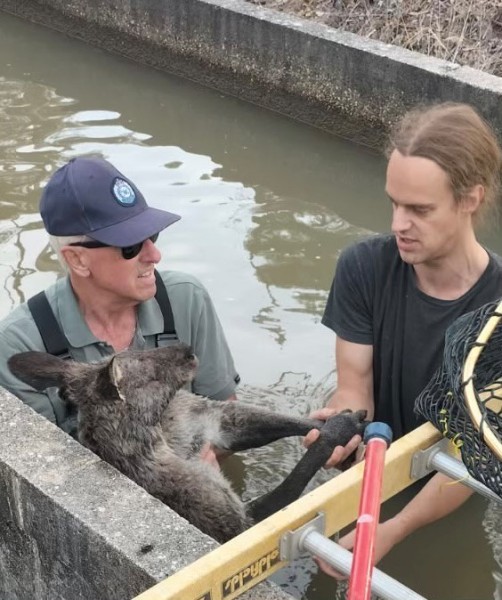
Volunteer rescuers Ian Slattery (left) and Sam Brand (right) cradle an injured kangaroo in the Coliban Water Channel. Photo: Brian Mayberry
A kangaroo was saved from the Coliban Main Water Channel by wildlife rescuers after it was attacked by an off-leash dog in Elphinstone on March 28.
Volunteers from Wildlife Victoria were called to the scene and managed to extract the 70kg male kangaroo from the water channel, before providing medical assistance. He was taken to the Hepburn Wildlife Shelter for care.
Rescuer Ian Slattery said the kangaroo suffered multiple bite wounds to the arm and shoulder. He claimed authorities were not effective at enforcing local animal laws.
“As rescuers, we are really sick and tired of these cases where owners are just irresponsible,” he said.
“In the case of dog attacks, owners are not held accountable.”
Mount Alexander Shire Council’s Animal Management Plan states a dog may be declared “dangerous” if it causes serious injury to another animal, and require it to have a muzzle, lead and adult handler at all times in public spaces.
“We know a dog was not contained to its property and the owner of that animal will receive an infringement for that offence,” a council spokesperson said.
The council requires statements from a witness to take further action but two people present at the scene did not see the attack.
Wildlife Victoria officials told the Express that over the past three years they had received 2723 reports of injured kangaroos in Mount Alexander Shire and 5743 reports of injured kangaroos in the Macedon Ranges. Most of these incidents in the region have involved collision with a vehicle.
Slattery said the 70km water channel had been another long-term issue for kangaroos, who periodically fell in and were unable to escape.
“We have for years been asking Coliban to make their water channels safe and they have done absolutely nothing about it,” he said.
A spokesperson for Coliban Water said the water authority was completing further analysis to better understand the movement of wildlife in the area to inform their decision-making around the installation of additional wildlife crossings.







